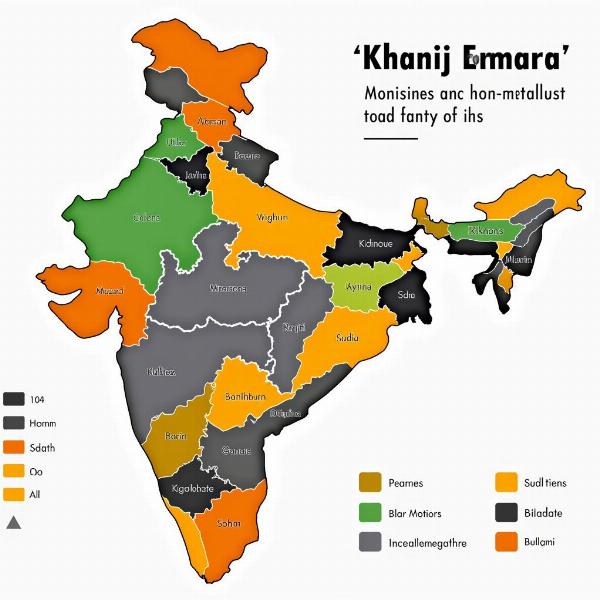Understanding the term “mineral wealth” and its Hindi equivalent is crucial for anyone interested in India’s economy, geography, or natural resources. “Mineral wealth” refers to the valuable minerals found within a specific region or country, encompassing everything from metals like iron and gold to non-metallic substances like coal and limestone. Knowing the Hindi term for this concept unlocks a deeper understanding of how these resources are discussed and valued within Indian culture.
Unveiling the Hindi Translation of Mineral Wealth
The most common and accurate Hindi translation for “mineral wealth” is खनिज संपदा (khanij sampada). Khanij refers to minerals, while sampada signifies wealth or resources. This term effectively captures the essence of valuable mineral deposits. While other variations might exist, khanij sampada is widely understood and used throughout India. Understanding this term allows you to engage more effectively with Hindi resources related to mining, geology, and the economic impact of mineral resources.
Delving into the Significance of Khanij Sampada for India
India boasts a vast and diverse array of mineral resources, contributing significantly to its economic growth and industrial development. From the iron ore mines of Odisha and Chhattisgarh to the coalfields of Jharkhand and Madhya Pradesh, khanij sampada plays a vital role in various sectors. These resources are essential for manufacturing, infrastructure development, energy production, and even agriculture. Understanding the importance of khanij sampada provides insights into India’s economic landscape and its dependence on these natural treasures.
The Economic Impact of Khanij Sampada
The mining and processing of minerals generate employment opportunities, contribute to government revenue through taxes and royalties, and support the growth of ancillary industries. Moreover, the export of minerals contributes to India’s foreign exchange earnings. However, sustainable and responsible mining practices are crucial to minimize environmental impact and ensure long-term benefits.
Exploring Different Types of Khanij Sampada in India
India’s khanij sampada encompasses a wide range of metallic and non-metallic minerals. Metallic minerals, such as iron ore, bauxite, copper, and gold, are crucial for industrial development. Non-metallic minerals, including coal, limestone, and gypsum, play a vital role in construction, cement production, and fertilizer manufacturing.
Metallic Minerals: Powering Industrial Growth
Iron ore, a key ingredient in steel production, is found in abundance in states like Odisha, Chhattisgarh, and Karnataka. Bauxite, the primary source of aluminum, is found in states like Odisha, Jharkhand, and Gujarat. These metallic minerals are crucial for the automotive, construction, and manufacturing sectors.
Non-Metallic Minerals: Supporting Infrastructure Development
Coal, a vital energy source, is found in states like Jharkhand, Odisha, and Chhattisgarh. Limestone, essential for cement production, is widely distributed across India. These non-metallic minerals are crucial for infrastructure development, housing, and various industrial applications.
 Metallic and Non-metallic Minerals in India
Metallic and Non-metallic Minerals in India
Conclusion: Appreciating India’s Khanij Sampada
Understanding the meaning and significance of khanij sampada provides a valuable perspective on India’s natural resources and their role in the country’s economic development. From powering industries to supporting infrastructure, mineral wealth plays a critical role in shaping India’s future. Sustainable and responsible management of these resources is essential to ensure their long-term benefits for generations to come.
FAQs:
- What does khanij mean? Khanij means mineral.
- What does sampada mean? Sampada means wealth or resources.
- What is the most common Hindi translation for “mineral resources”? खनिज संपदा (khanij sampada).
- Why is khanij sampada important for India? It contributes to economic growth, industrial development, and employment generation.
- What are some examples of metallic minerals found in India? Iron ore, bauxite, copper, and gold.
- What are some examples of non-metallic minerals found in India? Coal, limestone, and gypsum.
- Where can I find more information about India’s mineral resources? You can find more information on government websites like the Ministry of Mines and the Geological Survey of India.
Meaning-Hindi.in specializes in providing accurate and culturally sensitive translation services between Hindi and various other languages. Our expertise spans a wide range of domains, including business and commercial documents, legal and certified translations, technical manuals, website localization, educational materials, and specialized content. We also offer expedited translation services for urgent projects. Whether you need to translate documents related to mining, geology, or any other field, our team of expert linguists is dedicated to delivering high-quality translations that meet your specific needs. Contact us today at [email protected] or call us at +91 11-4502-7584 to discuss your translation requirements. Meaning-Hindi.in is your trusted partner for all your Hindi translation needs.